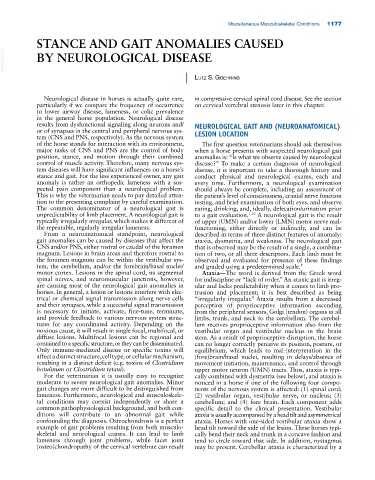Page 1211 - Adams and Stashak's Lameness in Horses, 7th Edition
P. 1211
Miscellaneous Musculoskeletal Conditions 1177
STANCE AND GAIT ANOMALIES CAUSED
VetBooks.ir BY NEUROLOGICAL DISEASE
lutz S. goehring
Neurological disease in horses is actually quite rare, in compressive cervical spinal cord disease. See the section
particularly if we compare the frequency of occurrence on cervical vertebral stenosis later in this chapter.
to lower airway disease, lameness, or colic prevalence
in the general horse population. Neurological disease
results from dysfunctional signaling along neurons and/ NEUROLOGICAL GAIT AND (NEUROANATOMICAL)
or of synapses in the central and peripheral nervous sys
tem (CNS and PNS, respectively). As the nervous system LESION LOCATION
of the horse stands for interaction with its environment, The first question veterinarians should ask themselves
major tasks of CNS and PNS are the control of body when a horse presents with suspected neurological gait
position, stance, and motion through their combined anomalies is: “Is what we observe caused by neurological
control of muscle activity. Therefore, many nervous sys disease?” To make a certain diagnosis of neurological
tem diseases will have significant influences on a horse’s disease, it is important to take a thorough history and
stance and gait. For the less experienced owner, any gait conduct physical and neurological exams, each and
anomaly is rather an orthopedic lameness with a sus every time. Furthermore, a neurological examination
pected pain component than a neurological problem. should always be complete, including an assessment of
This is why the veterinarian needs to pay detailed atten the patient’s level of consciousness, cranial nerve function
tion to the presenting complaint by careful examination. testing, and brief examination of both eyes, and observe
The common denominator of a neurological gait is eating, drinking, and, ideally, defecation/urination prior
unpredictability of limb placement. A neurological gait is to a gait evaluation. 1,10 A neurological gait is the result
typically irregularly irregular, which makes it different of of upper (UMN) and/or lower (LMN) motor nerve mal
the repeatable, regularly irregular lameness. functioning, either directly or indirectly, and can be
From a neuroanatomical standpoint, neurological described in terms of three distinct features of anomaly:
gait anomalies can be caused by diseases that affect the ataxia, dysmetria, and weakness. The neurological gait
CNS and/or PNS, either rostral or caudal of the foramen that is observed may be the result of a single, a combina
magnum. Lesions in brain areas and therefore rostral to tion of two, or all three descriptors. Each limb must be
the foramen magnum can be within the vestibular sys observed and evaluated for presence of these findings
tem, the cerebellum, and/or the forebrain/basal nuclei/ and graded using a predetermined scale. 5
motor cortex. Lesions in the spinal cord, its segmental Ataxia—The word is derived from the Greek word
spinal nerves, and neuromuscular junctions, however, for indiscipline or “lack of order.” An ataxic gait is irreg
are causing most of the neurological gait anomalies in ular and lacks predictability when it comes to limb pro
horses. In general, a lesion or lesions interfere with elec trusion and placement; it is best described as being
trical or chemical signal transmission along nerve cells “irregularly irregular.” Ataxia results from a decreased
and their synapses, while a successful signal transmission perception of proprioceptive information ascending
is necessary to initiate, activate, fine‐tune, terminate, from the peripheral sensors, Golgi (tendon) organs in all
and provide feedback to various nervous system struc limbs, trunk, and neck to the cerebellum. The cerebel
tures for any coordinated activity. Depending on the lum receives proprioceptive information also from the
noxious cause, it will result in single focal, multifocal, or vestibular organ and vestibular nucleus in the brain
diffuse lesions. Multifocal lesions can be regional and stem. As a result of proprioceptive disruption, the horse
contained to a specific structure, or they can be disseminated. can no longer correctly perceive its position, posture, or
Only immune‐mediated disease or specific toxins will equilibrium, which leads to mal‐interpretation in the
affect a distinct structure, cell type, or cellular mechanism, (fore)brain/basal nuclei, resulting in delays/absence of
resulting in a distinct deficit (e.g. toxins of Clostridium movement initiation, maintenance, and control through
botulinum or Clostridium tetani). upper motor neuron (UMN) tracts. Thus, ataxia is typi
For the veterinarian it is usually easy to recognize cally combined with dysmetria (see below), and ataxia is
moderate to severe neurological gait anomalies. Minor noticed in a horse if one of the following four compo
gait changes are more difficult to be distinguished from nents of the nervous system is affected: (1) spinal cord;
lameness. Furthermore, neurological and musculoskele (2) vestibular organ, vestibular nerve, or nucleus; (3)
tal conditions may coexist independently or share a cerebellum; and (4) fore brain. Each component adds
common pathophysiological background, and both con specific detail to the clinical presentation. Vestibular
ditions will contribute to an abnormal gait while ataxia is usually accompanied by a head tilt and asymmetrical
confounding the diagnosis. Osteochondrosis is a perfect ataxia. Horses with one‐sided vestibular ataxia show a
example of gait problems resulting from both musculo head tilt toward the side of the lesion. These horses typi
skeletal and neurological causes. It can lead to limb cally bend their neck and trunk in a concave fashion and
lameness through joint problems, while facet joint tend to circle toward that side. In addition, nystagmus
(osteo)chondropathy of the cervical vertebrae can result may be present. Cerebellar ataxia is characterized by a

